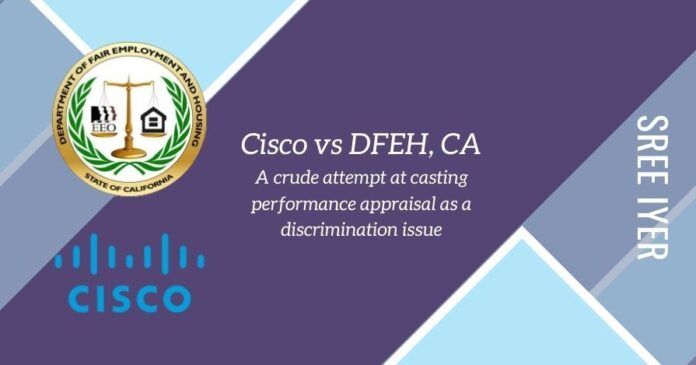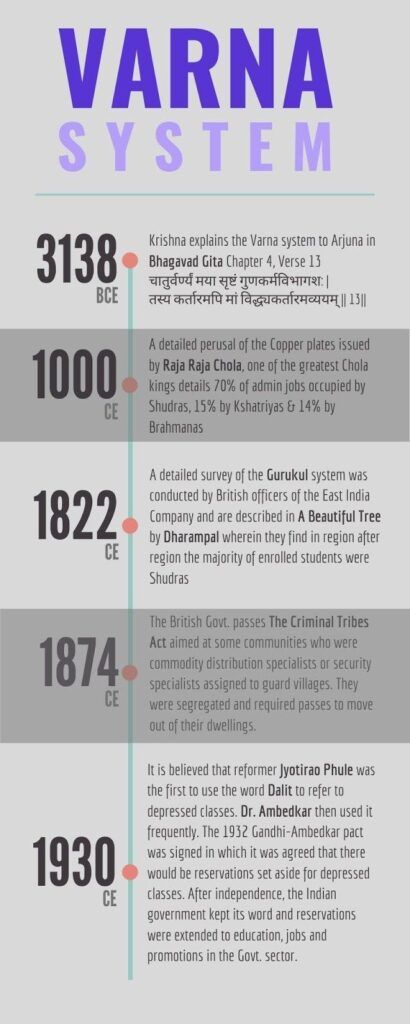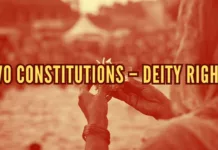
I have had a chance to peruse the 22-page lawsuit being brought by the California Department. of Fair Employment and Housing (DFEH) against Cisco Systems. The first paragraph itself had so many anomalies that I figured it would be instructive to capture the correct depiction of India’s history and its thousands-of-years-old Varna system.
What is the Varna system?
In ancient India two great Rishis, Rishi Bhrigu and Rishi Bhardwaj met to discuss how to form a stable society. Then Rishi Bhrigu said there are four sources of power in a society and we must ensure that nobody has more than one of that. The four sources are knowledge, weapons, wealth, and land. These should not be in one hand, not even two should be in one hand. So those who have knowledge will not have wealth, will not have weapons, and will not have lands. Those who will have weapons will rule the country, but they will not make policy. They need to go to people having the knowledge to seek their permission and advice. Those who are having wealth, their social status will be decided by how much philanthropy they do, not by their wealth. Those who have lands must produce for society. In fact, none of these four categories or “Varna” was based on birth[1]. In fact, Rishi Atreya said that everyone is born a Shudra until he chooses a vocation, which defines one’s varna.
There were as many as 126 universities spread through Akhand Bharat (a modern-day region comprising Pakistan, India, Bangladesh, Nepal, Sri Lanka, and Sikkim).
Caste is a Portuguese word
Caste or Casta is a Portuguese word used to denote class. The Portuguese arrived in India in 1498, when Vasco Da Gama set foot in modern-day Goa. This word is loosely equated with Jati, a word that is used to denote someone’s specialty (and in some cases his commonality as the context goes; e. g. jati of weavers). The Sanskrit word Vigyani (scientist) over time changed to Gyani (knowledgeable) to Jati in modern times. So where did the word Dalit come from? Read on…
Krishna explains the Varna system in Bhagavad Gita

As illustrated in Figure 2 (Given below), Krishna tells Arjuna, “The four categories of occupations were created by me according to people’s qualities and activities. Although I am the creator of this system, know me to be the non-doer and eternal[2].”

Padma Bhushan awardee Dr. Nagaswamy, in his book Tamil Nadu – The Land of Vedas details from reading copper plate inscriptions during the reign of Rajaraja Chola (985 CE to 1014 CE) as to how the government administration composed of 70% Shudras, 15% Kshatriyas and 14% Brahmanas (Page 401).
A detailed survey of the Gurukul system was conducted by British officers of the East India Company around 1822 and are detailed in A Beautiful Tree by Dharampal wherein they find in the region after region the majority of enrolled students were Shudras[3]. When Lord Macaulay introduced the English-based education system, it dealt a death blow to the Gurukul system, which was in vogue. There were as many as 126 universities spread through Akhand Bharat (a modern-day region comprising Pakistan, India, Bangladesh, Nepal, Sri Lanka, and Sikkim). This meant that a sizable number of people lost their means of learning education. Since the majority of the students in these Gurukuls were Shudra-born, they suffered the most under the new British dispensation.
The independent Indian government kept its word when India became free in 1947 when reservations were extended to education, jobs, and promotions in the government sector.
The aftermath of India’s 1st war of independence
In 1857, almost all of India rose up to fight against the British in what is known as the First war of independence. The British called it the Sepoy Mutiny. The British were a few thousand in number and were running a country that was already around 250 million in population. They needed to ensure that the country remained divided and fought amongst itself instead of fighting the real oppressor, in this case, the British. Two significant things the British brought in after 1857:
- The Zamindari system.
- Criminal Tribes Act of 1871[4].
The Zamindari system was brought by Lord Cornwallis of the East India Company in 1793 through a Permanent Settlement Act[5]. Introduced first in Bengal, Bihar, Orissa, and Varanasi, it spread to the rest of the areas under British rule after 1857, when the British found unsavory characters and made them Zamindars by snatching the land from farmers, who the British thought supported the First war of independence. In many cases, the village thug thus suddenly became a Zamindar (landowner) and could levy any tax on this area of jurisdiction as long as he paid British the promised amount.
In 1871, the British wanted to completely break down the means by which the farmers were selling their produce. Throughout India, there were communities who were distribution specialists and could manage to fetch the farmer the best price for his produce. To do this, they earmarked several such communities and made them as outcastes, with draconian laws that required them to have “special permits” even to leave their village. The British stamped them as ‘hereditary criminals’ and thereby made them the “untouchables”.
The word Dalit was first used in the 1930s by a reformer Jyotirao Phule to refer to depressed classes, such as the ones above. Dr. Ambedkar then used it frequently in his writings. The 1932 Gandhi-Ambedkar pact was signed in which it was agreed that there would be reservations set aside for depressed classes. And the independent Indian government kept its word when India became free in 1947 when reservations were extended to education, jobs, and promotions in the government sector.
In conclusion
The DFEH has made several errors in Paragraph 1. One wonders if the due application of mind and diligence was done before drafting this petition. The petition also is mixing up skin color (a result of pigmentation change based on how long one spends under the sun) to state that the darkest are Dalits. There are about 534 shades of skin color in the Indian sub-continent and anyone whose livelihood depends upon spending a sizeable amount of time in the sun will have a darker complexion. The DFEH is confusing what appears to be a disgruntled employee not happy with his performance evaluation with that of discrimination leading to a filing of this lawsuit.
An individual instance of a possible case of mistreatment or bias should not be projected at the entire Hindu religion and the Indian American diaspora. A number of factual errors and sweeping statements made in DEFH’s petition demand scrutiny of what went into framing it.
References:
[1] Subramanian Swamy says Caste system is not on the basis of Birth in Hindu religion – YouTube
[2] Bhagavad Gita: Chapter 4, Verse 13 – Holy Bhagavad Gita.org
[3] The Beautiful Tree – Dharampal
[4] THE CRIMINAL TRIBES ACT AND THE DECLINE OF KAVAL SYSTEM Chapter 6 – Shodh Ganga
[5] Land Revenue Systems in British India: Zamindari, Ryotwari and Mahalwari – ClearIAS.com
- Indian Parliament’s Special Session is convened to mark the shifting to new Parliament building - September 3, 2023
- Why did Rajat Sharma of India TV not declare that Adani owns more than 16% shares in his channel? - January 29, 2023
- Prannoy Roy to get Rs.605 crore from Adani as per Stock Exchange filing. Why is Income Tax not acting on Roys’ dues of over Rs.800 crore? - January 4, 2023











Are we missing the point? Is the goal really to get caste added as a protected characteristic?
Then all Indians will be suspected of undue benefits because of birth unless they easily show, you know, that they are not upper caste Hindus?
What’s the agenda behind the suit and why is the plaintiff anonymous?
Are we missing the point? Is the goal really to get caste added as a protected characteristic?
Then all Indians will be suspected of undue benefits because of birth unless they easily show, you know, that they are not upper caste Hindus?
What’s the agenda behind the suit and why is the plaintiff anonymous?
What is the definition of a Dalit? Anyone can claim that he/she is a Dalit, as all it means is an ‘Oppressed’. This complaint has to come to India for evidence. Is the person really belong to a caste that is listed in the Scheduled Caste list? Is the certificate genuine or was given after a payoff. In all probability the guy has left his religion.
Anyone remember the case of an Osmania University student belonging to Vaddera caste (Gajapathi Kings) claiming to be a Dalit, who committed suicide and blamed his ‘Dalit Caste’ for his misfortunes? Also his mom had already left the religion.
This case is under the perview of American contitution. Particular company mentioned here was bit laid back along with Motorlo and gave away the pole position to Huawei. It was around 2003, these companies settled legal disputes with Huawei for a token amount without foreseeing trillions of dollor losses in the coming decades. I would say the current cold war is due to the inefficiences of these companies and its executives. No class here.
[…] खबर को अंग्रेजी में यहाँ […]
Good & informative article
It is a short concise and yet appears to be a complete beautifully wriiten article for anybody to pick up and either present or arm themselves with the right knowledge .